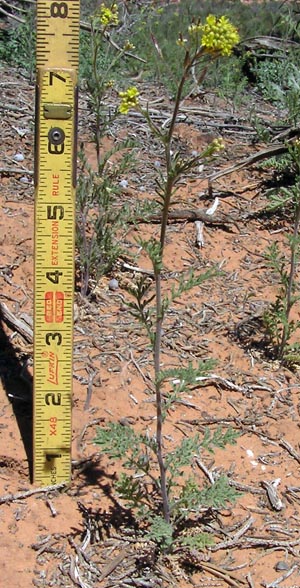Tansymustard

Common Name(s):
Tansymustard
Western Tansymustard
Scientific Name:
Descurainia pinnata (Walt.) Britt.
Scientific Name Synonyms:
None known
Symbol:
DEPI
Description:
Life Span: Annual
Origin: Native
Season: Cool
Growth Characteristics: An erect forb, growing 4 to 32 inches high, with a single stem or a branched stem, growing from a taproot. Flowers March to August, reproduces from seeds. Tansymustard plants are showy when flowering but become ragged and inconspicuous as seed matures.
Flowers/Inflorescence: Petals are white to bright yellow, sepals rose-colored. Flower occurs in series of 4 (4 petals, 4 sepals), hence the family name Cruciferae (crucifix).
Fruits/Seeds: Fruits are siliques, with two cells, and several seeds per cell. Seeds borne on a pedicel.
Leaves: Alternate, usually bipinnately compound. The blades at the top of the plant are usually smaller and more simply pinnate. Leaves lightly to densely pubescent.
Ecological Adaptions:
Tansymustard is a widespread weedy species that grows on a variety of sites. It occurs in waste places, disturbed areas, plains, dry hillsides, prairies, open woods, and along streambanks. Tansymustard grows most commonly along ditches, roadsides, or on other disturbed, open sites where mineral soil has been exposed. In parts of western Utah, it is particularly common in areas that have been subjected to high levels of rodent disturbance.
Soils: Adapted to a broad range of soils, most abundant in dry or sandy soils.
Associated Species: Cheatgrass, Russian thistle, bur buttercup.
Uses and Management:
Tansymustard is poisonous to cattle in the southwest. Symptoms of poisoning in cattle include "paralyzed tongue" or an inability to swallow food and water, partial or complete blindness, and aimless wandering. Generally, it results from consuming large quantities of plant material. Poisoning can be easily avoided since tansymustard is green earlier in the spring than most forage species.
Tansymustard is fair to good forage for sheep and goats. Its palatability declines with maturity.
Seeds of tansymustard were used by American Indians to make pinole flour. Young plants were used as a potherb.

